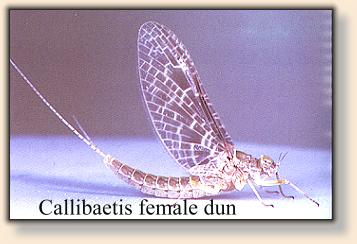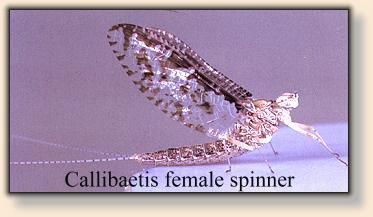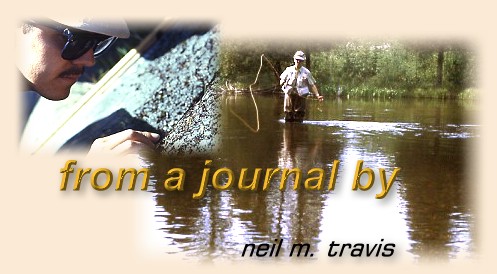The Gray Ghost of Summer
By Neil M. Travis, Montana
Are you familiar with Callibaetis, the gray ghost of summer?
Callibaetis are one mayfly that I look forward to each year,
and when they appear I can be assured that trout will soon
be actively feeding.
Callibaetis are common insects on western waters especially on
lakes and ponds. They also are found on slower weedy sections
of rivers, but they reach their greatest numbers on stillwaters.
On productive waters they hatch in tremendous numbers with
densities that match the blanket hatches of caddis flies and
midges.
Callibaetis are multibrooded, and produce up to four broods
per year. Peak hatches take place in May and June, August,
and again in September. During the warmer months nymphs may
reach maturity in five weeks. Once they begin to hatch it is
usually possible to find some insects hatching every day until
the season ends so the fish are always aware of their presence
and willing to feed on them if the opportunity presents itself.
Anglers should note that Callibaetis get smaller as the season
progresses. The earliest hatching flies are noticeably larger
than the flies that hatch at the end of the season. I carry
imitations that range from a size 14 to 18 to cover the size
variation that I find on the waters around my Montana home.
The nymphs are very active, and have slender, tapered bodies.
They have three tails that are equal in length and fringed
with tiny hairs, and the gills are heart-shaped. They are
active swimmers, and if you look around weed beds you will
often see them darting about with burst of activity.
Anglers should be aware that both the nymphs and adults show
a remarkable variation in body color from one place to another,
and even from one month to the next. It appears that the nymphs
take on the color of their surroundings, and the nymphs that
over winter under the ice are usually drab-colored, but with
the warming of the water and increasing weed growth the nymphs
become more colorful. Adults also vary widely in body color,
and like the nymphs their color changes during the season. I
have found that the adults that hatch during the midsummer
here in Montana are the lightest gray, while the early and
late season insects are a darker gray. Successful anglers
note these changes in size and color and have patterns that
more correctly imitate the hatching insects.
Callibaetis nymphs should be tied long and slender to imitate
the naturals. Tiers should be aware that the thorax is a
pronounced feature of the natural, and should be emphasized
on their imitation.
Fishing a nymph just before the hatch begins is often a very
productive method. The naturals become very active just before
they hatch repeatedly swimming to the surface and back to the
weeds. They usually dart to surface rapidly and then drift back
down to the weeds. I like to use a lightly weighted nymph cast
just off the edge of the weeds during this period. I allow the
nymph to sink and then I slowly lift the rod tip bring the nymph
to the surface. A weighted nymph fished deep with a short stripping
retrieve around the edge of weed beds is productive when adults
are not actively hatching.

During the hatch of duns one of my favorite fishing methods is
to select a position just off the edge of large weed bed where
the duns are actively hatching. The lakes that I fish have very
clear water and I can normally see the trout cruising along just
under the surface looking for hatching insects. When I locate a
cruising trout I quickly cast my imitation a few feet ahead of
him. The sight of my imitation dropping on the surface of the
water is often just the stimulus that the trout needs to tip
up and sip in my offering. Another productive method is to
slowly drift along the edge of a weed bed casting to cruising
trout as they gulp in the naturals. This can be frustrating as
a large trout sips a natural bobbing just inches from your
imitation, and then changes direction and swims the other way.
Often the first indication that Callibaetis are present is a
spinner flight. The males gather over the water, and their
flight is a fast, vertical series of undulations over the water
and nearby areas. I have often witnessed heavy spinner flights
some distance from the nearest water. After mating the females
rest in the trees, shrubs and grasses allowing their eggs to
ripen. When the females return to the water to lay their eggs
they dip the tip of their abdomen into the water, and since
the eggs have been allowed to ripen in the body of the female
they hatch very shortly after ovipositing.
As the hatch progresses it is not unusual to find both duns and
spinners on the water at the same time. Although I have seldom
found actively feeding trout to be selective during these
occasions, eating both duns and spinners as the opportunity
presents itself, the angler should be aware that some individual
fish may be selective preferring duns or spinners. On one occasion
I found that the trout near the weed beds were only taking duns,
but down the shoreline away from the weed beds they were only
taking spinners.

Like the duns, spinners are larger in the spring than later in
the season. As the spinners decrease in size trout will sometimes
completely ignore the spinner fall, and only feed actively on the
duns. A cloudy calm day early in the season with a heavy spinner
fall may produce some of the finest stillwater fly-fishing of
the year.
Large trout are often caught using Callibaetis imitations, and
anglers should use the heaviest tippets possible to avoid
breaking off in the weeds. I normally try to use 4x tippets
when fishing near the weeds only going to 5x when I consistently
get refusals.
Of all the hatches of summer I always look forward with my greatest
anticipation to the beginning of the Callibaetis hatch. When the
gray ghosts begin to dance over my favorite trout lakes I am filled
with the expectation of great angling opportunities. I hope that you
have some gray ghosts hatching near on your home water, and that you
have a chance to experience them soon. ~ Neil M. Travis, Montana/Arizona
From A Journal Archives
|

